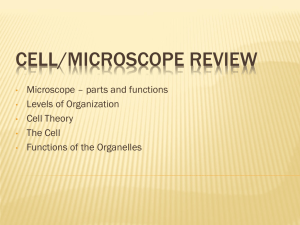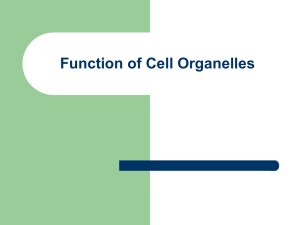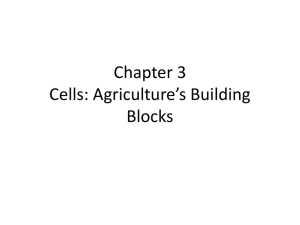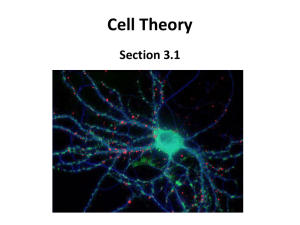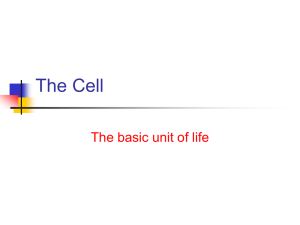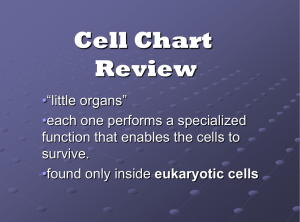Chapter 4
advertisement
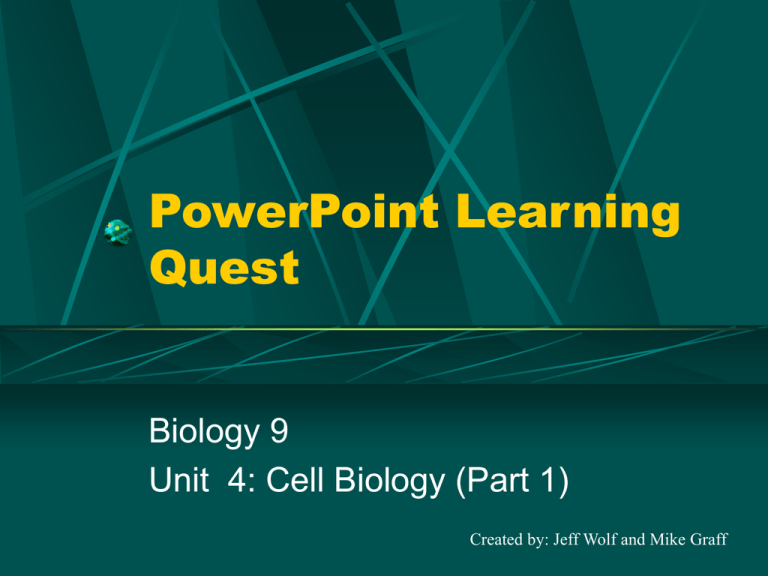
PowerPoint Learning Quest Biology 9 Unit 4: Cell Biology (Part 1) Created by: Jeff Wolf and Mike Graff Objectives: After completing this Learning Quest the student will… Demonstrate the use of a microscope in the analysis of cells. Compare and contrast between prokaryotic cells, eukaryotic cells, and viruses. Assemble a replica of a bacteria cell, a plant cell, and an animal cell given the organelles for each type of cell. Sketch and describe the structure and function of cell organelles. Human Red Blood Cells Directions 1. 2. 3. 4. Plant Cell Follow the instructions in the Anticipation Guide found in this PowerPoint Presentation. Follow the instructions and answer all questions found in the Learning Guide. Follow the instructions in the Conclusion Guide. ALL THREE GUIDES CAN BE FOUND IN THIS LEARNING POWERPOINT QUEST. Anticipation Guide (Page 1) Before diving into the world of cells and their importance to living organisms, it is important to understand how we can even investigate the world of cells. Microscopes are necessary to investigate cells because of their microscopic size. Many cells are as small as 1/1000 of a millimeter. Anticipation Guide (Page 2) Refer to textbook pages 58 – 60. Many lab scientists, college students, and even yourself have used a particular type of microscope called a light microscope. A light microscope is able to see microscopic objects because visible light passes through the object or specimen. Glass lenses are then used to enlarge the image and project the image in order to make that image visible. An example of a light microscope. Anticipation Guide (Page3) Two more examples of a light microscope. Anticipation Guide (Page 4) A more complex microscope, originally built in the 1950’s is called an electron microscope. A electron microscope uses beams of electrons instead of light to produce a image of the microscopic object. These beams of electrons assist the electron microscope in producing a clearer image as well as a much better resolving power than that of the light microscope. The most powerful modern electron microscopes can distinguish objects as small as 0.2 nanometer. This is a thousand times more powerful than any light microscope. An example of a electron microscope. Anticipation Guide (Page 5) The two important parts to using microscopes in the scientific investigation of cells are magnification and resolving power. Magnification is how larger objects appear compared to their actual size. Resolving power of a microscope determines how clear that magnified image can be seen. As seen in the chart to the left the human eye, the light microscope, and the electron microscope all have certain abilities and limits when it comes to viewing microscopic objects. Anticipation Guide (Page 6) Shortly after the discovery of the light microscope a scientist named Robert Hooke was the first to describe the shape of cells. In 1665, Hooke discovered that cells were located in a thin slice of cork taken from the bark of an oak tree. By the mid-1800’s scientists began to find cells in every organism they investigated using a light microscope. This investigation produced the cell theory which states that all living things are composed of cells. An example of a plant cell. Learning Guide (Page 1) Now that an explanation of cell investigation has been made let’s talk about the two major classes of cells. The two major classes of cells are prokaryotic cells and eukaryotic cells. Refer to pages 61-63 of your textbook. An example of a prokaryotic cell. An example of a eukaryotic cell. Learning Guide (Page 2) Prokaryotic Cells vs. Eukaryotic Cells Prokaryotic Cells Bacteria cells. Came before Eukaryotic cells. Contains DNA but no nucleus and no membrane bound organelles. Smaller than Eukaryotic cells. Considered to be primitive or more simplistic than a Eukaryotic cell. Eukaryotic Cells Protists, plants, fungi, and animal cells. Developed after the Prokaryotic cells. Contains a nucleus and membrane bound organelles. Larger than Prokaryotic cells. Considered to be more complex and better organized due to the presence of a nucleus. Learning Guide (Page 3) Viruses, on the other hand ARE NOT CELLS! Viruses, like the one pictured to the right are just packaged genes with a small bit of nucleic acid wrapped inside of a protein coat. The reason why viruses are not considered a cell organism is because viruses must use resources within cells to reproduce and thrive. Viruses are non-living entities that require a living host in order to reproduce. Refer to pages 191-195 and Genetic Material Learning Guide (Page 4) Animal Viruses are often a main cause of disease. A flu virus, seen to the left uses Proteins spikes to enter and leave a cell, therefore infecting one or more cells. Like many other animal viruses, the flu viruses have RNA rather than DNA as their genetic material. Another example of an RNA virus is the common cold. Learning Guide (Page 5) When a virus comes into contact with a weakened cell, the virus can enter and eventually reproduce. The diagram to the right shows the reproductive cycle of a RNA virus (the mumps virus). Learning Guide (Page 6) The reproductive cycle of a virus is seen here in seven steps. Step 1: The Virus enters the cytoplasm through the plasma membrane (the outer surface of the cell). Step 2: Enzymes then remove the protein coat that existed inside the virus’ shell-like envelope. Learning Guide (Page 7) Step 3: An enzyme enters the cell as part of the virus. That enzyme uses the virus’s RNA genome as a template for making strands of similar RNA strands (purple strand). Step 4: The new strands now has two functions. First to serve as mRNA for the synthesis of new viral proteins. Second (SEE STEP 5), to serve as templates for creating new viral genome RNA. Learning Guide (Page 8) Step 6: A new protein coat forms a whole new copy of the virus and then wraps around the new RNA. Step 7: Finally, the virus leaves the cell by hiding in the cell’s plasma membrane. In summary, the virus obtains its envelope from the cell, leaving the cell without necessarily damaging it. Learning Guide (Page 9) The structure of a cell is very similar to the structure/organization of a factory. Each part or organelle inside the cell helps the cell to develop and survive just like the factory workers, supervisors and a maintance crews help the factory to function. Refer to pages 64 – 75. A factory. A cell. Similar? Learning Guide (Page 10) The outer skin of a animal cell is called the cell membrane or plasma membrane. The plasma membranes function (job) is to cover and contain the cell contents. In addition, the plasma membrane is also semi-permeable which means the membrane allows some substances to enter into the cell while prohibiting other materials that may be too large or very harmful to the cell. Learning Guide (Page 11) Inside the very center of the cell is the largest organelle in the animal cell. This organelle is called the Nucleus. This is the foreman or boss of the animal cell. The nucleus contains the DNA (I.e. the cell’s blueprints), the chromosomes, and genetic information needed for the cell to reproduce and develop. The nucleus also controls the cell’s other functions, as well as, its protein production. The nucleus, like that of the cell membrane, is semipermeable. Learning Guide (Page 12) Within the nucleus is a spherical structure known as a nucleolus. The nucleolus produces ribosomes that are transported throughout the cell. Make sure you study the individual organelles and their functions between the pages of 62 – 75. Learning Guide (Page 13) Found throughout the cell are small spherical organelles called Ribosomes. Ribosomes produce cell protein using your genetic code. Ribosomes are found primarily on the surface of the rough endoplasmic reticulum. Ribosomes could be considered the product manufactures within the “cell factory”. Learning Guide (Page 14) Surrounding the Nucleus is the “conveyer belt” of the cell known as the Endoplasmic Reticulum. The endoplasmic reticulum, found inside the cell is presented in two forms. The first form, the rough endoplasmic reticulum – has ribosomes on its surface (or Rough ER), assists in the transportation of protein within the cell. The second form, the smooth endoplasmic reticulum (or Smooth ER), lacks ribosomes. The Smooth ER’s job is to make enzymes and to detoxify waste material. Both the Rough and Smooth ER attach to an organelle called the Golgi Body. Learning Guide (Page 15) The Golgi Body (also known as the Golgi apparatus) is found connected to the endoplasmic reticulum. The function of the golgi body is to modify and package cell products such as protein. Basically, the golgi body is the “packing and shipping center” of the cell. Learning Guide (Page 16) The kidney-shaped organelles that can be found throughout the cells are called the Mitochondria. The mitochondria are often known as the “boiler room of the cell”. The mitochondria produce energy by creating ATP (chemical energy). Mitochondria are often referred to as the respiration centers of the cell because they require oxygen to produce ATP. The mitochondria will use carbohydrates and fats obtained in your diet in order to create this power for the cell. Mitochondria will lose 58% of the food energy due to heat. Learning Guide (Page 17) Flowing in-between the organelles of the cell is a watery gel called Cytoplasm. Cytoplasm is used for support and to help suspend the organelles within the cell. It also assists in giving the cell some shape, due to fluid pressure known as turgor pressure. Learning Guide (Page 18) The waste or “trash disposal system”of the cell is known as a Lysosome. Lysosomes digest food and worn out cell parts that are no longer used by the cell. The Lysosomes are sometimes considered “Suicide Sacs” because they contain digestive enzymes to eliminate harmful bacteria and digest other materials and plays a role in waste disposal. Learning Guide (Page 19) Practice Assessment #1 – Draw a blueprint of a factory. Place and describe how the following organelles would function within a “cell factory”. After completing this activity please turn it into your teacher. Cell Membrane Endoplasmic Reticulum (E.R) Nucleus Golgi Body Nucleolus Mitochondria Ribosomes Cytoplasm Lysosomes Learning Guide (Page 20) Centrioles are unique structures found only in animal cells. The centrioles main function is to provide aid in the process of cell reproduction. Learning Guide (Page 21) The Vacuoles are the “warehouse” of the cell. The Vacuoles not only hold water but may also hold food, pigment, and waste safely inside the cell. Large vacuoles are a common feature found in plant cells. Animal cells may only have small vacuoles. They provide turgor pressure (fluid pressure) that stabilizes the plant cell. Learning Guide (Page 22) Short hair-like surface extensions found found on the outside of the cell are called Cilia. Cilia often cover the surface of some cells and can aid in movement or keeping an area clean by a sweeping action. Examples include cilia found within the respiratory system, female reproductive tract and cilia that cover the bodies of some microscopic pond organisms. Learning Guide (Page 23) Found on the outside of some cells is a long whip-like extension called a Flagellum. Flagella provide the cell with locomotion/movement capabilities. Examples include the whiplike tail on a sperm cell and the tail on a pond organism called a Euglena. Learning Guide (Page 24) Microtubules provide assistance in cell shape by creating a cytoskelton. The Microtubules help in managing internal movement of organelles within the cell. Learning Guide (Page 25) Another protein-based organelle used in movement is the Microfilaments. The microfilaments not only assist in movement but the microfilaments assist in development of the cells shape. Learning Guide (Page 26) The cell wall, the outer boundary or “factory wall” of the plant cell provides support and protection for all plant cells. The cell wall has a rigid outer covering made of nondigestible cellulose. Cell walls are made of the carbohydrate known as cellulose. Learning Guide (Page 27) Our final organelle, found only in plant cells are called plastids. The plastids main function is to manufacture glucose, store food and pigments. They include the chloroplasts (food production), leucoplasts (food storage), and chromoplasts (provide pigmentation/color to the plant. Learning Guide (Page 28) Practice Assessment #2: Using the “cell factory” blueprint created in practice assessment #1, add the following organelles to your factory. Centrioles Microtubules Vacuoles Microfilaments Cilia Cell Wall Flagella Plastids Learning Guide (Page 29) The final section in this unit is dedicated to tissues. Tissues are the result of specialized cells working together. If you have tissues working together they will form an organ and eventually organ systems. The four tissues that make up the human body include, nerve tissue, muscle tissue, epithelial tissue, and connective tissue. Learning Guide (Page 30) Nerve tissue are made up of individual cells called neurons. These vital tissues specialize in transmitting information rapidly from one part of the body to another. An example of a nerve tissue. Neuron Learning Guide (Page 31) Breakdown of a muscle tissue. Muscle tissue are a specialized group of cells that help in the movement of organs and appendages. The three types of muscle tissues are: Skeletal Visceral Cardiac The next slide will provide greater detail on muscles. Learning Guide (Page 32) Skeletal Muscle Visceral Muscle Cardiac Muscle Skeletal muscles are voluntary muscles that produce rapid body movement. Most of the body consists of striated skeletal muscles Visceral muscles are involuntary muscles that produce slow sustained contractions. These muscles can be stretched several times their original length without loss of their function. Visceral muscles are found in many tubeshaped body structures such as in the digestive system. Cardiac muscle is found only in the heart. These striated muscles and their cells are capable of contracting spontaneously. This muscle is also striated and involuntary. Learning Guide (Page 33) Epithelial tissues covers the entire body surface. Epithelial tissues are both external and internal. A good example of a epithelial internal tissue is the surface layers of skin lining the digestive and respiratory systems. As a protective covering, the epithelial tissue may absorb and/or secrete chemicals to and from the specific organ. The cells contained within the epithelial tissue are so closely fused together that blood vessels cannot pass between them. Layered epithelial tissues. Learning Guide (Page 34) Connective tissues can also be found throughout the human body. Examples of connective tissues are: ligaments, tendons, bone, cartilage, fat, and blood. What do all of these types of connective tissues have in common. Connective tissues found in cartilage. With the exception of fat tissue all of these types of connective tissues have a large amount of material (intercellular material or matrix) separating their cells. Conclusion Guide (Page 1) Practice Assessment #3: Complete the follow questions on a separate sheet of paper and hand in to your teacher. Refer to your notes and chapter 4 in your text for assistance. 1. A prokaryote has a.a cell nucleus. b. a cell membrane. c. organelles d. all of the above. 2. The growth of cells is limited by the ratio between a. volume and surface area. b. organelles and surface area c. organelles and cytoplasm. d. nucleus and cytoplasm. 3. A cell membrane is composed of a. lipids b. proteins c. nucleic acids. Conclusion Guide (Page 2) 4. The function of the Golgi apparatus is to a. synthesize proteins b. release energy c. process and package proteins d. synthesize lipids. 5. Mitochondria a. transport materials. b. release energy. c. make proteins. d. control cell division. 6. Lysosomes function in cells to a. recycle cell parts. b. destroy disease causing agents. c. shape developing body parts. d. all of the above. Conclusion Guide (Page 3) 7. The nucleolus is a. the control center of the cell. b. the storehouse of genetic information. c. the site where ribosomes are synthesized. d. none of the above. 8. Plant cells differ from animal cells in having. a. fluid-filled vacuoles. b. cell walls surrounding the cell membrane. c. chromoplasts. d. all of the above. 9. Leucoplasts a. synthesize proteins b. store food. c. synthesize pigments. d. store pigments. Conclusion Guide (Page 4) 10.The stomach is an example of a. a tissue. b. an organ. c. an organ system. d. none of the above. 11. How have microscopes been helpful in the study of cell? 12. What limits the size of the cells? 13. Why is the cell membrane called a selectively permeable membrane? 14. Distinguish between the structure of rough ER and that of smooth ER. 15. What is the cell specialization? Give and example of cell specialization. Conclusion Guide (Page 5) Practice Assessment #4: Reviewing Vocabulary. Write the word or phrase that best completes each statement below. 1. 2. 3. 4. 5. 6. 7. A structure outside the plasma membrane in some cells is the ________. The functions (command center) of a eukaryotic cell are managed by the ________. In a cell, the tangles of long strands of DNA form the _______. The folded system of membranes that forms a network of interconnected compartments inside the cell is called the ________. The pigment that gives plants their green color is ________. The network of very tiny rods and filaments that forms a framework for the cell is called the__________. In plants, the structures that transform light energy into chemical energy are called ________. Conclusion Guide (Page 6) Practice Assessment #5: Vocabulary Review Part 2. Write the term in parentheses that makes each statement correct. 1. 2. 3. 4. 5. 6. 7. 8. (Phospholipids, Transport proteins) make up the selectively permeable membrane that controls which molecules enter and leave the cell. Short, hair like projections used for locomotion are (cilia, flagella). In the cell the breakdown of molecules in order to release energy occurs in the (mitochondria, Golgi apparatus). An organism with a cell that lacks a true nucleus is a(n) (prokaryote, eukaryote). The movement of materials into and out of the cells is controlled by the (cytoplasm, plasma membrane). The small, membrane-bound structures inside a cell are (chromatin, organelles). In a cell, the sites of protein synthesis are the (ribosomes, nucleolus). Cell structures that contain digestive enzymes are (plastids, lysosomes). Conclusion Guide (Page 7) Practice Assessment #6: Understanding Concepts Part A. Choose the letter of the word or phrase that best completes the statement. 1. Cell walls of multicellular plants are composed mainly of -cellulose -chitin -pectin -vacuoles. 2. The terms least closely related to the others is -cytoskeleton -microfilaments -microtubule -cell juncture 3. In a chloroplast, the stacks of membranous sacs are called -stroma -grana -plastids -thylakoid membrane 4. The structure most responsible for maintaining cell homeostasis is the -cytoplasm -mitochondrion -cell wall - plasma membrane 5. If a cell contains a nucleus, it must be a(n) -plant cell -eukaryotic cell - animal cell - prokaryotic cell Conclusion Guide (Page 8) 6. One advantage of electron microscopes over light microscopes is their -size -two-dimensional image -higher magnification –use of live specimens 7. When a cell is ready to reproduce, its DNA is packed into (use page 64) - chromosomes -chromatin -nucleoli -nucleoids 8. The scientist who first described living cells as seen through a simple microscope was. -van Leeuwenhoek -Schleiden -Hooke -Schwann 9. Each of the following is a main idea of the cell theory except -all organisms are composed of cells -the cell is the basic unit of organization of organisms -all cells are similar in structure and function -all cells come from preexisting cells 10. A plasma membrane is made up of a(n) -cholesterol layer -enzyme bilayer -phospholipid bilayer -protein layer Conclusion Guide (Page 9) Practice Assessment #7: Understanding Concepts Part B. The diagram below of a bacterium shows a light area with no surrounding membrane in the center of the cell. This area contains a single large DNA molecule . Use the diagram to answer questions of the following slide. Conclusion Guide (Page 10) 1. 2. 3. 4. Identify the structures labeled A, B, and D. Based on the diagram above, would a scientist classify this cell as a prokaryote cell or a eukaryote? Explain. In plants, cells that transport water against the force of gravity are found to contain many more mitochondria than do some other plant cells. What is the reason for this outcome? Why did it take almost 200 years after Hooke discovered cells for the cell theory to be developed? Works Cited http://www.cellsalive.com/cells/3dcell.htm http://www.iwire.com.br/guilherme/common/images/misc/wallpapers/bloodcells.jpg http://www.ucmp.berkeley.edu/plants/cells/elodeacell.jpg http://www.vetref.net/emscope/range01.gif http://www.prynearson.com/light-microscope-diagram-3.gif http://www.vetref.net/emscope/schematic.gif http://koning.ecsu.ctstateu.edu/cell/cell.gif http://www.awcommunity.org/objects/ananas/virus!.jpg http://lattas.org/city%20of%20lights.jpg http://www.bradford.ac.uk/staff/pghopkin/factory.gif http://www.emc.maricopa.edu/faculty/farabee/BIOBK/BioBookAnimalTS.html http://www.meddean.luc.edu/lumen/MedEd/Histo/HistoImages/hl3-03.jpg After completing the test move onto Unit #5
